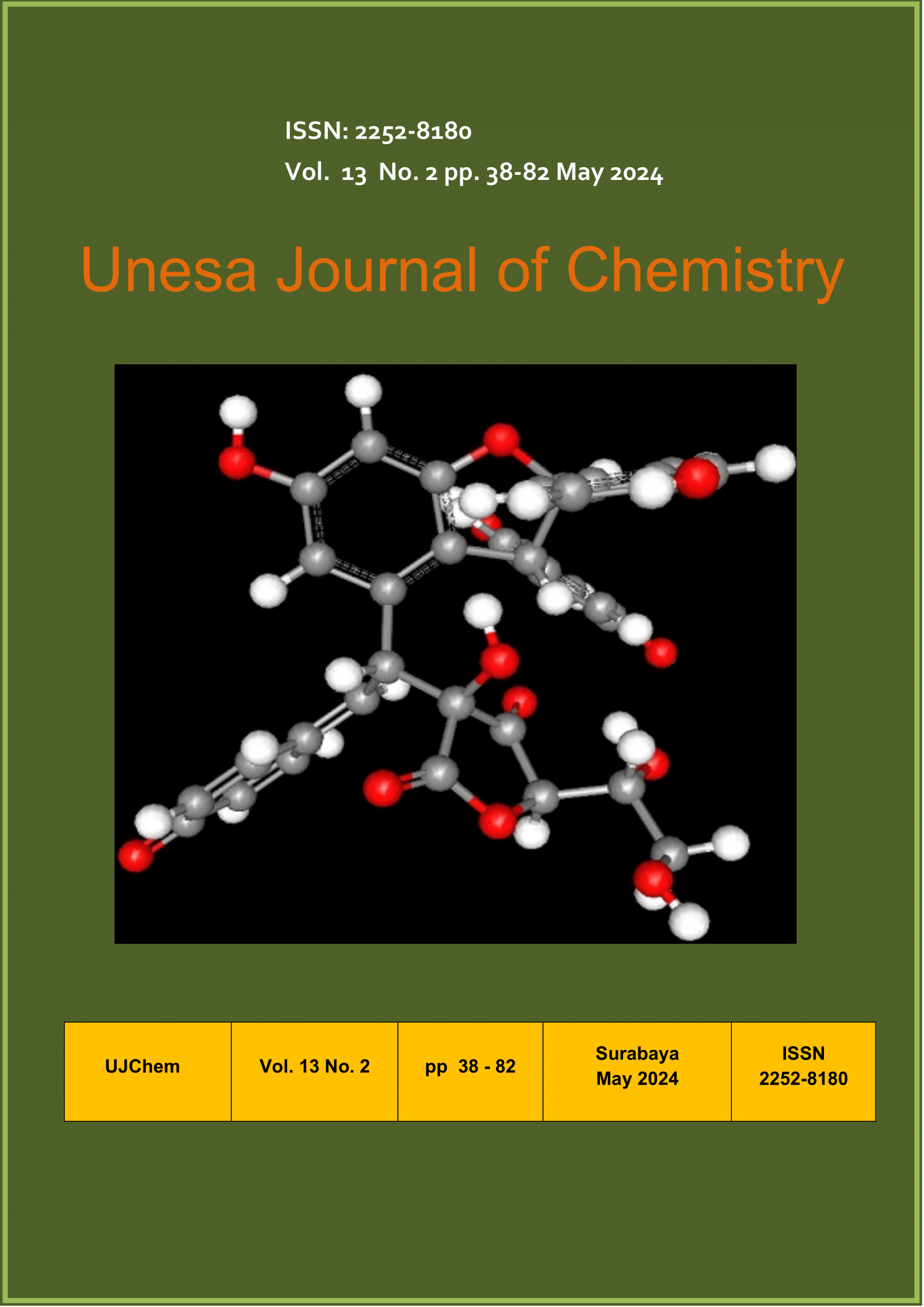EXPLORATION OF CARBAZOLE ALKALOID COMPOUNDS Murraya microphylla AS ANTICANCER INHIBITORS SIRT1 AND CDK9: IN SILICO STUDY
Main Article Content
Abstract
Cancer is currently a major health problem due to its significantly increasing number of deaths and prevalence, including breast cancer and cervical cancer. The development of new drugs is a major effort to overcome the risk of cancer. Natural compounds are the main source of medicinal compounds and are believed to have lower toxicity than synthetic drugs. This study aimed to reveal the anticancer activity of Murraya microphylla carbazole alkaloids as SIRT1 and CDK9 inhibitors in silico. Based on the results of molecular docking simulations, isomahanimbine and mahanimbine compounds were obtained as SIRT1 inhibitors, and girinimbine and koenigine compounds were obtained as CDK9 inhibitors with binding energy values lower than those of control inhibitors, indicating that these compounds have potential as anticancer agents. Prediction of the physicochemical properties, drug-likeness, and pharmacokinetics of the four compounds showed good results and fulfilled the criteria for medicinal compounds. Further research is needed to reveal the potential of these compounds as anticancer drugs.
Downloads
Article Details

This work is licensed under a Creative Commons Attribution 4.0 International License.
References
1. E. A. Waters, J. Muff, and J. G. Hamilton, 2014, Multifactorial beliefs about the role of genetics and behavior in common health conditions: Prevalence and associations with participant characteristics and engagement in health behaviors, Genet. Med., vol. 16, no. 12, pp. 913–921, doi: 10.1038/gim.2014.49.
2. A. P. Wardana et al., 2022, 3,4,3′-Tri-O-methylellagic acid as an anticancer agent: in vitro and in silico studies, RSC Adv., vol. 12, no. 46, pp. 29884–29891, doi: 10.1039/d2ra05246f.
3. D. O. Nkwe et al., 2021, Anticancer Mechanisms of Bioactive Compounds from Solanaceae: An Update, Cancers (Basel)., vol. 13, no. 4989.
4. H. Sung et al., 2021, Global Cancer Statistics 2020: GLOBOCAN Estimates of Incidence and Mortality Worldwide for 36 Cancers in 185 Countries, CA. Cancer J. Clin., vol. 71, no. 3, pp. 209–249, doi: 10.3322/caac.21660.
5. Y. A. Sonawane, M. A. Taylor, J. V. Napoleon, S. Rana, J. I. Contreras, and A. Natarajan, 2016, Cyclin Dependent Kinase 9 Inhibitors for Cancer Therapy, J. Med. Chem., vol. 59, no. 19, pp. 8667–8684, doi: 10.1021/acs.jmedchem.6b00150.
6. M. I. Abdjan, N. S. Aminah, I. Siswanto, A. N. Kristanti, Y. Takaya, and M. I. Choudhary, 2021, Exploration of stilbenoid trimers as potential inhibitors of sirtuin1 enzyme using a molecular docking and molecular dynamics simulation approach,” RSC Adv., vol. 11, no. 31, pp. 19323–19332, doi: 10.1039/d1ra02233d.
7. Andika, L. Erlina, Azminah, and A. Yanuar, 2018, Molecular dynamics simulation of sirt1 inhibitor from indonesian herbal database,” J. Young Pharm., vol. 10, no. 1, pp. 3–6, doi: 10.5530/jyp.2018.10.2.
8. B. Varghese et al., 2023, SIRT1 activation promotes energy homeostasis and reprograms liver cancer metabolism, J. Transl. Med., vol. 21, no. 1, pp. 1–17, doi: 10.1186/s12967-023-04440-9.
9. E. Zhao et al., 2019, The roles of sirtuin family proteins in cancer progression, Cancers (Basel)., vol. 11, no. 12, pp. 1–22, doi: 10.3390/cancers11121949.
10. T. M. Thant, N. S. Aminah, A. N. Kristanti, R. Ramadhan, H. T. Aung, and Y. Takaya, 2020, Cytotoxic Carbazole Alkaloid from the Root of Clausena cxcavata on Hela Cell Line,” no. May 2020, pp. 141–144, doi: 10.5220/0008858101410144.
11. W. W. Peng, L. X. Zheng, C. J. Ji, X. G. Shi, Z. H. Xiong, and X. C. Shangguan, 2018, Carbazole alkaloids isolated from the branch and leaf extracts of Clausena lansium, Chin. J. Nat. Med., vol. 16, no. 7, pp. 509–512, doi: 10.1016/S1875-5364(18)30087-6.
12. H.-N. Lv, K.-W. Zeng, B.-Y. Liu, Y. Zhang, P.-F. Tu, and Y. Jiang, 2015, Biological Activity and Chemical Constituents of Essential Oil and Extracts of Murraya microphylla, Nat. Prod. Commun., vol. 10, no. 9.
13. O. Trott and A. J. Olson, 2010, AutoDock Vina: Improving the speed and accuracy of docking with a new scoring function, efficient optimization, and multithreading, J. Comput. Chem., vol. 31, no. 2, pp. 455–461, doi: 10.1002/jcc.21334.
14. E. Lara et al., 2009, Salermide, a Sirtuin inhibitor with a strong cancer-specific proapoptotic effect (Oncogene (2009) 28, (781-791) DOI: 10.1038/onc.2008.436),” Oncogene, vol. 28, no. 8, p. 1168, doi: 10.1038/onc.2009.1.
15. A. Daina, O. Michielin, and V. Zoete, 2016, SwissADME: A free web tool to evaluate pharmacokinetics, drug-likeness and medicinal chemistry friendliness of small molecules, Sci. Rep., vol. 7, no. October pp. 1–13, 2017, doi: 10.1038/srep42717.
16. K. Grillberger, E. Cöllen, C. I. Trivisani, J. Blum, M. Leist, and G. F. Ecker, 2023, Structural Insights into Neonicotinoids and N-Unsubstituted Metabolites on Human nAChRs by Molecular Docking, Dynamics Simulations, and Calcium Imaging,” Int. J. Mol. Sci., vol. 24, no. 17, doi: 10.3390/ijms241713170.
17. Z. Yin et al., 2023, LSD1-Based Reversible Inhibitors Virtual Screening and Binding Mechanism Computational Study, Molecules, vol. 28, no. 14, pp. 1–21, doi: 10.3390/molecules28145315.
18. C. Schlicker, G. Boanca, M. Lakshminarasimhan, and C. Steegborn, 2011, Structure-based development of novel sirtuin inhibitors, Aging (Albany. NY)., vol. 3, no. 9, pp. 852–872, doi: 10.18632/aging.100388.
19. H. Rasyid, B. Purwono, T. S. Hofer, and H. D. Pranowo, 2019, Hydrogen bond stability of quinazoline derivatives compounds in complex against EGFR using molecular dynamics simulation, Indones. J. Chem., vol. 19, no. 2, pp. 461–469, doi: 10.22146/ijc.39567.
20. R. Ruswanto, R. Mardianingrum, and A. Yanuar, 2022, Computational Studies of Thiourea Derivatives as Anticancer Candidates through Inhibition of Sirtuin-1 (SIRT1), J. Kim. Sains dan Apl., vol. 25, no. 3, pp. 87–96, doi: 10.14710/jksa.25.3.87-96.
21. A. M. Shawky, N. A. Ibrahim, M. A. S. Abourehab, A. N. Abdalla, and A. M. Gouda, 2021, Pharmacophore-based virtual screening, synthesis, biological evaluation, and molecular docking study of novel pyrrolizines bearing urea/thiourea moieties with potential cytotoxicity and CDK inhibitory activities,” J. Enzyme Inhib. Med. Chem., vol. 36, no. 1, pp. 15–33, doi: 10.1080/14756366.2020.1837124.
22. S. Yasmeen and P. Gupta, 2019, Interaction of Selected Terpenoids From Dalbergia sissoo With Catalytic Domain of Matrix Metalloproteinase-1: An In Silico Assessment of Their Anti-wrinkling Potential, Bioinform. Biol. Insights, vol. 13, doi: 10.1177/1177932219896538

